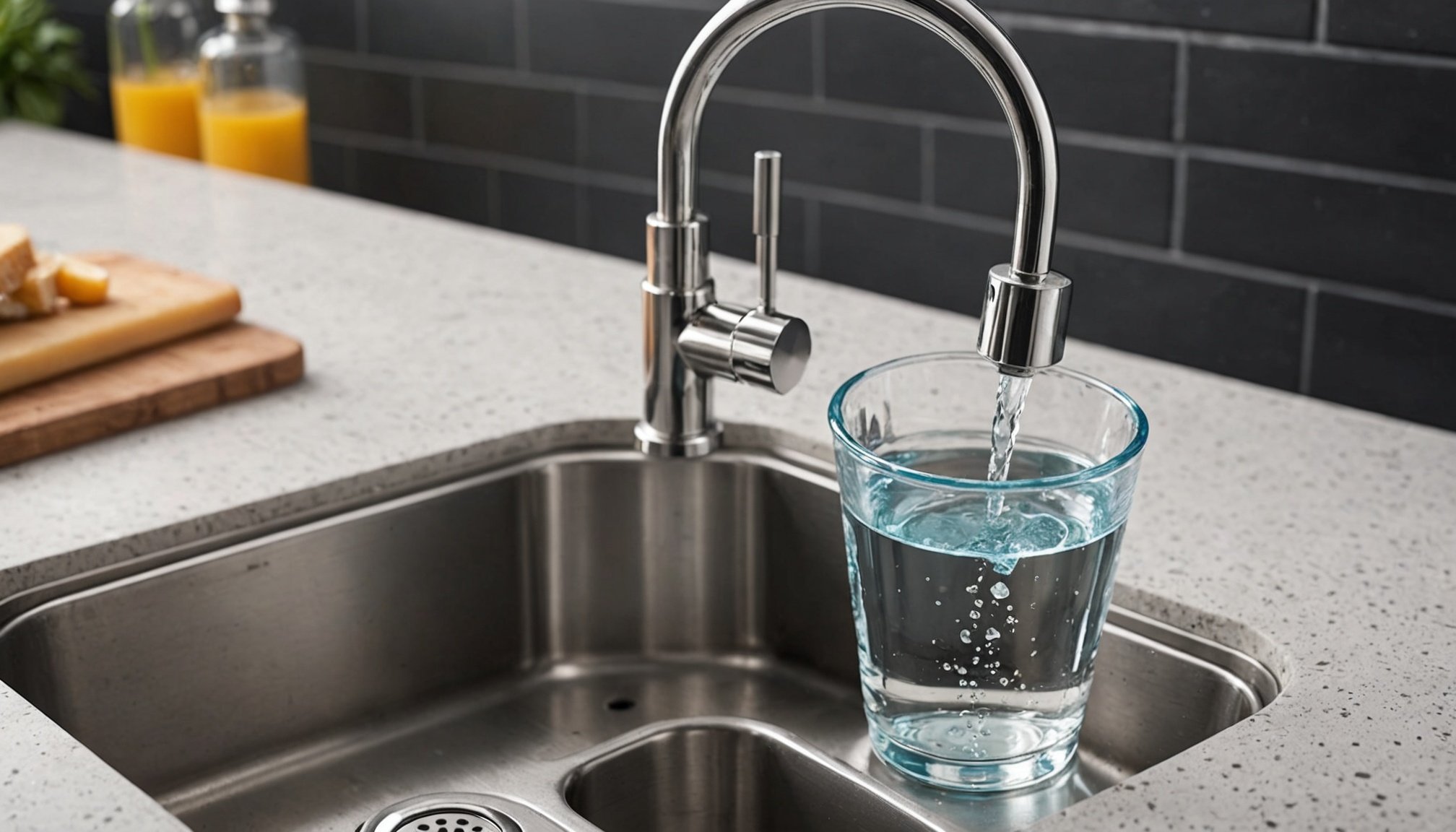Understanding Hard Water and Its Effects
Hard water is a common issue in many households, particularly in the UK. It is characterised by high concentrations of calcium and magnesium, which accumulate as water moves through limestone and chalk deposits. These minerals cause water to become “hard,” influencing its interaction with various surfaces.
The effects of hard water are extensive, notably impacting household appliances and plumbing systems. Over time, mineral deposits, known as limescale, build up in pipes, water heaters, and appliances, such as dishwashers and washing machines. This accumulation can significantly reduce the efficiency of appliances, leading to increased energy consumption and potentially costly repairs or replacements.
In the same genre : Top thermoses that transform your daily experiences
Regarding health implications, hard water consumption is generally not harmful. However, its high mineral content can potentially lead to dry skin and hair. It may also affect the taste and texture of beverages and food, although some individuals prefer this unique quality.
Addressing hard water issues requires a nuanced understanding of its characteristics and effects. By identifying the problem and exploring solutions, like filtration systems, households can mitigate negative impacts, ensuring a smoother and more efficient water experience while maintaining health considerations.
Have you seen this : Transforming Sleep: How UK Families Can Leverage Smart Technology to Enhance Sleep Hygiene in the Bedroom
Types of Home Filtration Systems for Hard Water
Hard water can cause numerous challenges, but home filtration systems offer practical solutions. Different filtration types, such as water softeners, reverse osmosis, and carbon filters, can cater to various needs.
Overview of Various Filtration Systems
Water Softeners: These specialists in reducing calcium and magnesium levels, effectively addressing hard water issues. They replace hard minerals with sodium or potassium ions, ensuring a smoother water experience.
Reverse Osmosis: Known for its ability to remove various impurities, this comprehensive system forces water through a semi-permeable membrane to deliver clean, soft water. It’s perfect for those prioritizing purity.
Carbon Filters: These utilize activated carbon to improve taste and remove some contaminants. While not primarily for softening hard water, they can complement other systems for better overall water quality.
Pros and Cons of Each System
- Water Softeners: Excellent for softening but may cause sodium level concerns.
- Reverse Osmosis: Highly effective but requires more space and maintenance.
- Carbon Filters: Cost-effective but limited in tackling hard water minerals.
Recommendations for UK Residency
For UK residents, water softeners are ideal, especially in regions with the hardest water. Combining them with carbon filters can enhance both taste and quality.
Installation of Filtration Systems
When considering the installation of home filtration systems, some essential installation tips can help ensure a smooth process. Understanding whether to opt for professional installation or a DIY filtration setup can significantly influence the outcome.
Step-by-step Instructions for Installation
For those leaning towards a DIY approach, a water filtration setup begins with securing the right tools and materials. Tools like a wrench, screwdriver, and pipe cutter are typically necessary, alongside materials such as the filtration unit itself, pipes, and fittings.
Here are the basic steps:
- Select an appropriate location near the main water line for your filtration system.
- Turn off the water supply and relieve pressure by opening a faucet.
- Cut the pipe where the filter will be installed, ensuring a clean edge.
- Attach the fittings before securing the filter to the pipe.
- Check for leaks by turning the water back on gradually.
Professional vs. DIY Options
Weighing the pros and cons of professional installation against DIY is crucial. While professional services ensure expertise, they are costlier. Conversely, DIY can be budget-friendly but requires a careful approach to avoid mishaps.
Maintenance and Upkeep of Filtration Systems
Proper system maintenance is vital for extending the lifespan and efficiency of home filtration systems. Routine tasks like filtration upkeep ensure these systems operate smoothly, reducing the likelihood of complications.
A key aspect of maintenance is cleaning filters regularly. Manufacturers usually suggest cleaning or replacing filters every 3 to 6 months, depending on water quality and usage. Neglecting this could cause clogs, diminishing water flow and reducing filtration effectiveness.
Look out for signs indicating a need for maintenance or replacement. These may include an unusual taste or odour in the water, decreased water pressure, or visual signs of wear on the filter unit. Addressing issues promptly can save significant costs and inconvenience.
Cost-effective solutions are often available for maintaining filtration systems. For instance, purchasing filter replacement kits in bulk or opting for reusable filters can reduce expenses in the long run. Additionally, some systems offer self-cleaning options, helping reduce manual upkeep.
Regular upkeep not only assures better water quality but also safeguards the initial investment by preventing more significant issues. By staying attentive to system needs, you ensure continuous clean and safe water supply, ultimately leading to healthier living conditions.
Cost Comparisons of Filtration Systems
Investing in filtration system costs can yield considerable long-term savings. Initial expenses often vary, with water softeners ranging between £300-£1,000, while reverse osmosis systems might reach up to £500. Carbon filters, being the most budget-friendly, typically cost around £50-£150. Despite higher upfront costs, these systems significantly prolong the lifespan of household appliances, thereby reducing repair and maintenance fees over time.
When comparing installation costs, professional services might charge between £100-£500 depending on complexity, making DIY a tempting option for those looking to save. However, for technically intricate systems like reverse osmosis, professional installation can ensure optimal performance and avoid common DIY pitfalls.
Regarding maintenance, filtration upkeep costs should be considered. Water softeners often require ongoing salt purchases, while reverse osmosis and carbon filters need periodic membrane and cartridge replacements. These expenses contribute to overall costs but assure continuous water quality improvement.
Some regions may offer financial incentives or rebates to encourage the adoption of filtration systems. Exploring these options can alleviate initial costs, offering substantial financial relief while promoting a healthier living environment. Prioritizing drinking high-quality, safe water ultimately provides both economic and health benefits.
Health Benefits of Using Filtration Systems
Water quality improvement is critical for health. Consumption of safe drinking water offers numerous health benefits. Filtration systems play a key role in eliminating contaminants such as lead, chlorine, and pesticides from tap water, promoting a cleaner and healthier water supply. This is especially relevant in regions where water quality is compromised by pollutants.
Better water quality contributes to enhanced overall health, ensuring safer and more pleasant hydration experiences. It supports optimal bodily functions like digestion, nutrient absorption, and waste removal.
Filtration systems also address aesthetic concerns—improving taste and odour, which encourage more frequent water consumption, integral to maintaining good health. By removing impurities, these systems secure a reliable source of safe drinking water.
Staying hydrated is paramount for health, bolstered by quality water intake. Improved hydration can positively impact energy levels, cognitive function, and skin health, making filtration systems an invaluable resource for households.
An added benefit is the reduction of hard minerals that may negatively affect skin and hair, mitigating dryness often associated with unfiltered hard water. Incorporating filtration systems, therefore, aligns with a proactive approach to health and wellness.
Practical Recommendations for UK Residents
Navigating UK water issues requires knowledge and practical advice, particularly concerning hard water challenges. Each region varies in water hardness, influencing the choice of filtration systems. Areas like the South East are notorious for their extremely hard water, necessitating robust solutions.
To tackle these issues, consider:
- Water softeners for regions with high calcium deposits, like Kent or London. They are efficient in reducing limescale accumulation.
- Reverse osmosis systems can be impactful in areas with both hardness and contaminant concerns, offering comprehensive filtration.
Engaging with community resources is valuable. Local councils often provide regional advice and may offer programs to support residents in addressing water quality. Knowledge-sharing platforms or local forums can also be a great way to gather insights and DIY tips from fellow residents.
Embracing these solutions results in positive transformations. Success stories across the UK highlight improvements in appliance longevity and personal well-being after implementing filtration systems. These narratives not only inspire but also affirm the effectiveness of tailored filtration tips for regional adaptation.











